Alex Bledsoe's Blog, page 8
December 8, 2016
Some thoughts on Christmas, as the vile triumph around us
In 1992, Bruce Springsteen released a song called “Souls of the Departed,” on his album, Lucky Town. After describing the death of a seven-year-old boy killed in a gang-related drive-by, he observes,
His mama cried, “My beautiful boy’s dead”
In the hills the self-made men just sighed and shook their heads
But then, as always, Springsteen brings it down to the personal and immediate:
Tonight as I tuck my own son in bed
All I can think of is what if it would’ve been him instead
I want to build me a wall so high nothing can burn it down
Right here on my own piece of dirty ground
During this Christmas season, I’ve found myself thinking about all those children out there living in real, legitimate fear—the children of immigrants, the poor, the non-white, the LGBTQ—because of who the assholes in our country have chosen to lead us. The increase in hate crimes against those groups has been well-documented, and will only continue to grow. And I think about those parents, who must be filled with the worst kind of terror: the certainty that they can’t protect their children.
And as I tuck my own three children in bed, I think, “What if would’ve been them instead?”
And I share that terror. I have sons who will spend at least the next four years witnessing how everything I’ve tried to teach them—honesty, kindness, compassion, empathy—counts for nothing. You can be dishonest, unkind, and compassionless and still be chosen to lead what was once the greatest country in the world. And if that’s true, how can the decent ever succeed?
And I have a daughter who will learn that this vile president’s defining quote*, right up there with “I cannot tell a lie,” “Four score and seven years ago,” and “Tear down this wall,” will be, “Grab them by the pussy.” Them being women, and girls, and her.
Make no mistake: the assholes have won. Not the Right (or alt-Right), not the fundamentalist Christians (a topic for a whole other post), not the Conservatives. Not the racists, the xenophobes, or the homophobes. All those terms are mere smoke screens. Under it all, it’s just assholes, all the way down.
So during this holiday season, spare a thought for those who are truly in danger from this Cowardly New World. Do something kind for the most vulnerable among us. Wish at least a few moments’ peace for those children lying in bed, praying that God or Santa will make everything right. Wish that same peace for the parents who know that will never happen.
Because by next Christmas, it may be all of us.
*Until he comes up with something even worse. Which he will.
October 31, 2016
Some Halloween thoughts on NotLD
We had a breakthrough this past weekend: I finally convinced someone in my family to watch a zombie movie with me. My elder son, age twelve, joined me for the original Night of the Living Dead.
It’s hard to imagine, in 2016, seeing it with no preconceptions, and since I’m his father, the boy certainly didn’t. I’ve sung its praises all his life, and so he wasn’t so much surprised as finally able to give these tidbits a context. He’d also glimpsed some of the Rifftrax version, and it’s pretty much impossible to take it seriously after that (much as Spaceballs has ruined the chest-burster in Alien).
It definitely wasn’t like my first time seeing it. I was, if I remember correctly, a little older than him, living in a backwater Tennessee town of 350 during the seventies. We got exactly three TV channels (four if you count PBS, but we never did), and only one of those reliably. There was no cable in our town, so we used an antenna to pick up broadcasts.
We received two Memphis stations, channels 3 and 5. Again, if I remember correctly, it was channel 5, the NBC channel, that showed Night of the Living Dead one Sunday afternoon. At the time my knowledge of such things came mainly from Starlog and Famous Monsters, both of which called this a classic. So, knowing only that it was about zombies, I sat down to watch.
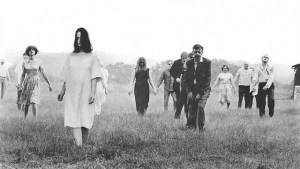
Two hours later, I continued to sit, speechless, wondering what the hell I’d just seen. It certainly wasn’t related to the Hammer films I watched every weekend (usually on channel 3, the CBS station). There were no moral absolutes: good not only didn’t triumph, it endured unremitting horror only to be randomly snuffed out. The ingenue and her generic boyfriend didn’t escape, they died, and then were eaten on screen. The hero did at least kill the villain, but then it turns out the villain had been right all along and the cellar was the safest place. Even a little girl died, became a zombie and ate her fucking parents.
It would be many years before I understood nihilism, or irony; but from that afternoon on, I understood horror.* Few subsequent films matched this experience, because you can only lose your horror virginity once; yet on that list I’d put The Exorcist, Session 9, [REC], and Island of Terror (the silicates still show up in my nightmares to this day).
Interestingly, years later when I got to college (University of Tennessee at Martin, also in west Tennessee), I found a little knot of people who’d also seen that same broadcast, and had a similar response. I’ve often wondered what the programmer at the station was thinking, but I’m pretty sure I know: he saw a movie from 1968, in black and white, and thought, “How bad can it be?” I doubt he set out to subversively traumatize a generation of local children.
Now, with zombies infiltrating every genre and every form of media, my son didn’t have remotely the same experience. I daresay he found it quaint, if interesting. Having a black hero no longer even seemed unusual, let alone groundbreaking. The gore was disturbing, but he’s seen worse in “T”-rated video games. He saw, in essence, what that long-ago station programmer thought he was showing. He certainly wasn’t traumatized, or had his whole view of a genre changed forever.
I shudder (un-ironically) to think what it would take to have that effect on him now, in 2016. At some level, I hope he never finds out.
Happy Halloween!
*Roger Ebert won a Pulitzer for observing something similar, but he didn’t experience it.
October 4, 2016
Some Thoughts from Down at the Crossroads
WARNING: Contains spoilers for the 1986 movie Crossroads (not the 2002 Britney Spears film). If you haven’t seen it, I wholeheartedly recommend it.
I recently rewatched Walter Hill’s movie Crossroads, and was surprised by how much I had internalized its depiction of the relationship between music and magic, and how that had influenced my own Tufa novels. I first saw it at a sneak preview prior to the Goldie Hawn football film Wildcats, and liked it so much I left before the main movie started; I didn’t want to lose the mood Crossroads left me with.
For those unfamiliar with it, the story involves Long Island teenager Eugene Martone (Ralph Macchio), who befriends elderly convict Willie Brown because he believes the old man is the last person living who might know a missing song by Robert Johnson, king of the delta blues. Eugene helps Willie escape to Mississippi, where he supposedly followed Johnson’s example and sold his soul to the devil, and now wants out of the deal.

Eugene (Ralph Macchio) and Willie (Joe Seneca)
The first thing that struck me during this rewatch was how realistic and lived-in most of the places, both in New York and down south, looked. After the pristine untouched Alabama depicted in the underwhelming Hank Williams film I Saw the Light, it was refreshing to see rusted old cars, people in bars who looked like real people as opposed to prettified extras, and even something as basic as a frayed screen on a door.
The second thing was the mundane depiction of the supernatural. When, in flashbacks, Willie sells his soul to the devil (known as “Legba,” a name erroneously borrowed from Haitian vodou), his satanic assistant, played by Joe Morton, arrives in a car, dressed in sophisticated clothes from the period, and gets Willie’s signature on a normal-looking contract (later, when that contract is shown again, it has a yellow carbon copy attached, like any modern contract would). In the contemporary story, Morton shows up again looking no older, but in a fancy modern sportscar and dressed in modern (circa 1986) clothes. When Legba, now calling himself “Scratch,” also appears, it’s with no effects; he simply walks into the scene. In fact, the only visual effect I recall, certainly the only one that’s meant to imply the supernatural except for some brief dream sequences, are fast-moving storm clouds matted in behind Scratch when he transports Willie and Eugene to “hell.”
The third thing was the interrelationship of music, experience, and magic. Eugene, at 17, is a guitar prodigy, first seen playing Mozart’s “Turkish March” on the guitar, which he finishes with a blues-style coda that his snooty teacher doesn’t appreciate. He’s also a blues fan, papering his walls with photos and articles and obsessing over the music of another culture the way only a sheltered white boy can. Willie taunts him about this from the beginning, mocking his background and playing, and trying in his abrasive way to get Eugene to reach down for something deeper than mere flawless technique. The first time Eugene really breaks through to that is when he’s abandoned by his brief romantic interest (Jamie Gertz), followed almost immediately by Willie admitting that there is no lost Robert Johnson song, and that he’s been using Eugene to get back to Mississippi.
And then, they go to hell.
It’s implied that this version of hell, an African American roadhouse circa 1920, is a personal one for Willie. Certainly everything about it seems to echo Willie’s life. And yet, when Eugene faces off against another guitarist for Willie’s soul, it’s heavy metal shredder Jack Butler (Steve Vai). That used to nag at me; why would Willie’s hell have a white boy as the devil’s guitarist? But then I realized that Butler has nothing to do with Willie; he’s a reflection of Eugene. Butler is confident, showy, and really, really good, all the things Eugene wants to be, all the things that he thought Johnson’s lost song would make him. It makes sense that the devil, now hoping to get Eugene’s soul as well, would conjure this image.

Eugene faces off against Jack Butler (Steve Vai) in “hell.”
So the finale pits Eugene against his own dark reflection. At first it’s an even match, but gradually Butler shows him up, culminating in a fiery display that Eugene clearly can’t match. But instead of trying, or giving up, he falls back on something that he can do: a Paganini guitar piece (Paganini also allegedly sold his soul to the devil), which Butler tries but fails to emulate. Thus Eugene wins not just with what he’s learned from Willie, but by combining it with his own experience. As Willie says at the end, “You have to take the music past where you found it,” which Eugene has already shown he can do.
Replace the word “music” with writing, art, even life itself, and it’s still good advice.
September 20, 2016
Flash Giveaway!
Taking a page from my pal Deborah Blake and offering a quick contest that’ll get you a copy of Chapel of Ease and–although it’s totally unrelated–one of the great albums of the late 80s that you’ve probably never heard.
Back in that long-ago time, my friend Hays introduced me to the music of Mississippi’s own Webb Wilder. His album Hybrid Vigor remains one of the few all-killer-no-filler discs that has held up to this day, 27 years later, from the opening chords of “Hittin’ Where It Hurts” to the final spoken “Ungawah!*”
I stumbled across an extra copy of it this weekend (because I ain’t giving away mine) at Frugal Muse in Madison. For a chance to win it, and a signed copy of Chapel of Ease, simply leave a comment below and tell me about your favorite all-killer-no-filler album before midnight Thursday. And of course, in the meantime, try to live by the Webb Wilder Credo:

* And you get bonus points if you know the source for this.
July 28, 2016
Announcing the Tufa Coloring Book
Hey, all you Tufa fans! Artist Shoshanah Marohn has put together a official coloring book featuring scenes from all four Tufa novels, at least one short story, and even a sneak image from the fifth book.
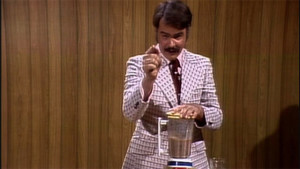
BUT WAIT! THERE’S MORE!
If you order it now, you can get $2 off the official price of $9.98. That’s right, from now until Chapel of Ease hits shelves on September 6, you can get the official Tufa Coloring Book for only $7.98.
Click on this link to order.
Seriously, though, the book is for real; Shoshanah approached me about it a few months ago, and has worked very hard to get it ready prior to the release of Chapel of Ease. Although I confess a little trepidation at first, I’m delighted with the results. If you’ve enjoyed my Tufa novels and stories, I think you’ll also really get a kick out of this.
Watch for an upcoming interview with Shoshanah about her experiences putting this together. And as always, if you like it, leave an honest review!
July 18, 2016
The original “Chapel of Ease”
As we close in on the September release of the fourth Tufa novel, Chapel of Ease, I wanted to share the song that gave the book its title. As with the prior three (and subsequent two) books in the series, the title comes from a song by Jennifer Goree (you can read about how our paths crossed here). It’s found on her second album, Don’t Be a Stranger, and she was kind enough to record a brand-new, exclusive live video for my readers. And don’t miss the chance to hear her perform it live at the Enchanted Chalice Renaissance Faire in Greenville, SC on September 9-10!
June 27, 2016
Godfather of Green: Danny Mullikin of Tuatha Dea on the Green Album
Last year, in one of the greatest bits of synchronicity I’ve ever been part of, the band Tuatha Dea released Tufa Tales: Appalachian Fae, an album based on and inspired by my first three Tufa novels. I was also lucky enough to appear at four different events with them, to be featured (briefly) in their video for “Wisp of a Thing,” and to be there when they saw the final cut of the video for “The Hum and the Shiver.”
Now they’ve spearheaded and released The Green Album, a collection of all-new tracks by fourteen of the best New Age, Celtic and Pagan-themed performers around: Ginger Doss, Wendy Rule, SJ Tucker, Bekah Kelso, Tuatha Dea, Damh The Bard, Celia Farran, Kellianna, Mama Gina, Brian Henke, Spiral Dance, Sharon Knight, Murphey’s Midnight Rounders and Spiral Rhythm.
Twenty-five percent of all proceeds from all 14 artists go to the Rainforest Trust. According to Danny Mullikin, leader of Tuatha Dea and spearhead of the project, “We just made our first donation to Rainforest Trust, and according to our current RF liaison, the proceeds from just our first three show dates at the Caldera Festival will be used to purchase 1,817 acres of the Balanga Forest in the Democratic Republic of Congo.
Danny was kind enough to answer some more in-depth questions about the project.
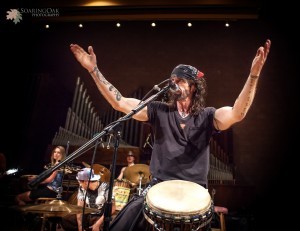
Danny Mullikin
1) How did you choose the Rainforest Trust as the beneficiary? What has their response been?
The idea hit me a couple of years back after we had finished up The Tribe CD and we were honored by guest musical appearances from some incredibly talented artists from all over. I remember thinking what an amazing community of musicians we were working in and how we had the platform to do something on a whole so much broader than it’s parts. I began sharing the idea with some of the artists we already had relationships with like Wendy Rule, SJ Tucker, Brad Murphey and Sharon Knight. The response was enthusiastic enough to let me know we were on to something.
We knew from the start what out theme was. After all, it’s a universal topic that concerns everyone. We knew we wanted it to be more than a musical celebration of our planet and we wanted to walk what we were talking (or singing) and really give something back.
We needed a partnership and somewhere we could put the fruits of the labor that would effectively create change. A lot of research was conducted by various Green Album artists and eventually we narrowed our sights down to three that met the criteria we were looking for. However, Rainforest Trust really hit the mark for us. It is an organization that takes direct action by identifying trouble spots and simply purchasing the land, saving both the environment and the species that live within it. But they go further by establish the land as Conservatory and thereby creating jobs for locals and much more. Their mission and directives reflected our goals and philosophies so entirely it was a no brainer.
2) How did you approach sequencing the tracks on the album?
The main difficulty was my own apprehension regarding getting it right and being responsible for the order and placement of 13 other amazing artist’s songs, all of which were phenomenal. The different styles and directions the artists pursued would normally be a concern but in the case of The Green Album this simply did not apply. There was a creative flow that occurred organically that made the project come together.

Ginger Doss
I listened to everyone’s song over and over again in various orders, listening for how one piece moved to the next, and the order created itself to some extent. From the moment I heard Ginger Doss’ “Gaea Lives,” I knew it was the opening track. It perfectly set the stage for the album and solidified the message of everything that followed. Spiral Rhythm’s solid groove in “Help It Grow” was the definitive last word and had to be the closer, bringing the album full circle.
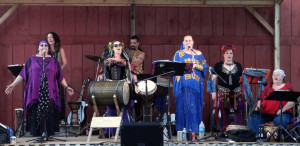
Spiral Rhythm
When I finished the proposed order I sent it out to all the artists and received a resounding and unanimous thumbs up. That was it. I simply followed the groove, feel, vibe and flow and feel like I lucked up and got it right.
3) What was it like premiering the album at Caldera Fest?
That was amazing! The universe really was at work. David Banash had been putting Caldera together for a while and we were scheduled to be there. We were working on The Green Album and 12 of the 14 artists were also on Caldera’s list. I contacted David about it and he graciously and enthusiastically gave The Green Album Caldera’s 30th and final slot. I knew the musicians were going to be awesome and was very familiar with all the music long before we arrived at Caldera and knew every song was off the hook, but the feeling of everyone coming together in such an unprecedented fashion and in a way that will probably never happen again…so perfectly and in such a spirit of unity…it defies description.
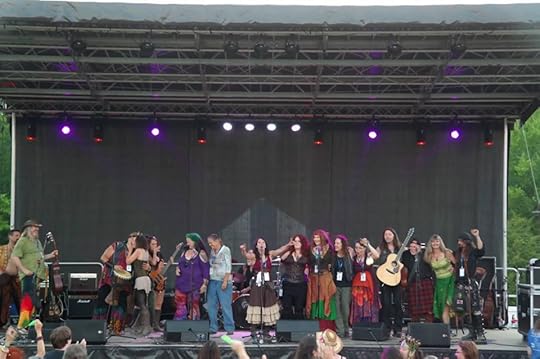
Caldera Festival
Each artist took the stage performing their contribution (some for the first time) and each honored one another by inviting other Green Album artists to play in. It was the most amazing and harmonious thing I’ve ever been part of. We closed out the Green Album concert with our song “Green,” and almost all of the Green Album artists present took the stage with us and played and sang along as hundreds of green glow sticks wavered in the air above the audience. It was our very own “We Are The World” moment. (laughs). The closing culminated in hugs, love and tears of joy. For us it was absolute utopia.
4) What artist(s) did you want to have participate that you couldn’t get?
There truly wasn’t anyone we asked who said no. Everyone jumped right in and no one invited declined. In fact, they all went above and beyond in creating this project and for the record we are all continuing to actively work together to spread the word.
Once the word got out about The Green Album and the philosophy and idea behind it, we were contacted by so many amazing artists who wanted to be a part and add their voices to the message. Unfortunately, a CD length is maxed out at 78 minutes and we had to stop at 14 artists to make sure we hit the mark. We considered going for a double album at one point but as we we’re self financing the project it simply wasn’t feasible.
There are so many incredible artists who volunteered that we could not fit onto the CD and I want to tell them all (you know who you are) how thankful we were for your musical offering of love! We missed you.
5) How did you decide on Tuatha Dea’s song contribution?
All the music on The Green Album is new. Either the artists created the music specifically for this album, or it was something in the “green” theme they had never recorded or released before.
In our case, “Green” was written specifically for The Green Album. This song was put together in a totally different way than anything we’ve written before and is a bit outside the box for Tuatha Dea. For a Tuatha Dea song, it was created entirely backwards. I had had the basic guitar part for the verses for a while. Music has a way of creating itself sometimes, and by the very nature of a piece it can carry you in a direction.

Tuatha Dea
I knew the song was “Green” before any other parts were established. It felt green. It was purposefully built from there in movements: transferring from minor key progressions to major with hopes of establishing both a melancholy vibe for what would later become the darker verses, and a sense of growing hope in it’s conclusion. The whole piece was written in D-A-D-G-A-D (Same as “Long Black Curl”) so hopefully the Appalachian, Celtic feel would seep through.
I paired off with the individuals in the group independently and each created their parts with the theme in mind but without any interaction with one another. Adam first created the secondary guitar establishing strong accents in the verses, reinforcing the choruses and trying to recreate the seasons in each of the four parts of the bridge. Tesea created her base part with a series of melodic flows rather than simple rhythm in mind. Then came Chantal Haskell, who recognized the message of the movements through violin before words were ever put to paper. Chris and Chantal worked together and alone to create the exchange between violin and penny whistle and finally the lyrics were born. I was trying to capture a sense of constrained aggravation and even anger about the circumstances of the earth and paint a sarcastic darker picture pertaining to our responsibilities, then pull things up by the boot straps by expressing a sense of hope through unity in the end. Becca and Kathy really nailed them down when they brought their down home bluegrass style harmonies into the mix.
Then finally…we threw all the parts together and Thus “Green” . Oh yeah…I mentioned it was written backwards. The last thing we did was add the drums. Certainly not typical of what we do. This may be the most organic piece of music we ever created. And isn’t that fitting.
The Green Album is available for purchase here.
June 4, 2016
Ode to Billie Joe: the value of the hidden
Yesterday was June 3rd, or as Bobby Gentry describes it:
It was the third of June, another sleepy dusty delta day….
That is, of course, from her magnificent ballad “Ode to Billie Joe,” a song as much about what’s unsaid (or unsung) as it is about what’s said. Billy Joe McAllister jumped off the Tallahatchie Bridge; the singer, a young (how young?) woman, had been seen with him earlier, throwing something off that bridge.
Here’s she is performing the song on a 1968 BBC TV show:
There’s a whole world in this song. Many things are described, but the immediate event is a lunch on a blistering hot day, and the lyrics reference food as much as what’s happened to Billie Joe. The phrasing is clearly done by a native, someone who knows the world she sings about. Lines such as,
Y’all remember to wipe your feet
and
Ol’ Billy Joe never had a lick’a sense; pass the biscuits, please
sound authentic because they are. I grew up hearing those same phrases, and when I hear the song, I can picture the table, the family, hear the flies buzzing and smell the mixture of cooking and sweat. I can also feel the tension between something that everybody knows, and something that no one would ever mention aloud. All families have secrets, but the worst ones are those right there in plain sight, like the black-eyed peas on the table.
But what’s fascinating about the song, and probably the big reason it remains popular after all this time, is that it doesn’t answer its own mystery. We never learn why Billie Joe jumped, or what he and the narrator were throwing off the bridge. There’s mention of a young preacher who has (predatory?) eyes on the narrator, and who spotted her and Billie Joe after church. Why did he “drop by” on the very day Billie Joe died?
Mysteries are powerful things. D.B. Cooper would be just another hijacker were it not for his total disappearance. Bigfoot would be a common zoo exhibit if we’d ever found one. Remember how Twin Peaks lost its mojo once it solved the mystery of Laura Palmer’s murder? Even Bobbie Gentry, the song’s composer and performer, is her own mystery, having totally vanished from public life in 1981 (here’s an article about where she might have ended up).
People have tried to solve the mystery. In the 1976 movie based on the song, he jumped because (gasp!) he had a homosexual encounter, certainly the worst thing people of the time could imagine. He’s also played by whiny Robby Benson, a sort of 70s Zac Ephron, and the object of his encounter is none other than James Best, soon to be immortalized as Sheriff Roscoe P. Coltrane on the Dukes of Hazzard. As directed by Max Baer (yes, Jethro from the Beverly Hillbillies), it’s an overheated, Absalom! Absalom! mess, a caricature of Southerness, and everything that Gentry’s song is not. An indication of its quality? Unless you were around when it came out, you’ve probably never heard of it.

And it exists simply to make obvious what is most powerful when left oblique. If the song had simply said, “My boyfriend killed himself today because I told him I was pregnant” (one of the many possible interpretations of the story), it would be just another country song. Certainly if it said, “My boyfriend killed himself because he got busy with his boss down at the sawmill,” which is what the movie claims, it would’ve had its five minutes of notorious fame, and then been filed away next to Ray Stevens’ “The Streak.”
So appreciate the mysteries for what they are, and the almost infinite possibilities the best ones provide for speculation. We’ll never know what motivated Billie Joe McAllister that sleepy dusty delta day, but we can sure have fun trying to figure it out.
(thanks to Jane Burns for inspiring this.)
May 25, 2016
Rocky IV: Electric Bugaloo
Every Thanksgiving, I have a Rocky-thon. Starting whenever I get up, it’s all Rocky, all day.
Except it’s a curated marathon. It includes Rocky I-III, Rocky Balboa, and now Creed. There’s no Rocky V, which no one seems to question. But how, folks ask, can I leave out Rocky IV?
Well, lemme tell ya.
I reviewed Rocky IV for my college paper when it came out in 1985, and I still remember my lead: “Rocky IV is a betrayal.” I still feel that way. The characters may be played by the same actors, the movie may be written and directed by Stallone, but there are virtually none of the qualities that made the first three movies so wonderful. Rocky IV is a comic book, and a dumb one at that: all montage and cheesy hair-band music, two-dimensional characters, and a hero who, based on the personality established in the previous movies, would simply never do what he does here.
Consider the all-important question of why he fights. In Rocky, it’s to prove he’s not “just another bum from the neighborhood” by going the distance against world champion Apollo Creed. In Rocky II, it’s to prove the first fight wasn’t a fluke, and that he’s capable of being a champion. In Rocky III, he has to reclaim his self-respect after learning that his manager has hand-picked all his opponents. In other words, in each case he’s fighting himself. The boxing match is just the vehicle for it.
In Rocky IV? He’s fighting for revenge. And ‘Murica. And I’m sorry, but the Rocky Balboa of the first three movies would not seek revenge. That’s just not him.
Still, I just picked up the complete Rocky set on blu-ray. And Apollo’s death in this film is the jumping-off point for last year’s wonderful Creed. So I thought I’d give Rocky IV another shot. Perhaps I remembered it wrong. Perhaps is does deserve to be added to my annual Rocky-thon.
Here, then, are some observations I jotted down, in chronological order.
—No Bill Conti music; instead, we get Vince DiCola. Mr. The Soft Drink has such classics on his CV as The Tranformers Movie (the animated one) and Staying Alive, the Stallone-directed sequel to Saturday Night Fever (if you haven’t seen it, I’ll leave it as a jewel for you to discover on your own).
—Rocky arrives home for his son’s birthday following the private fight with Apollo Creed that ended Rocky III and begins this movie. So his schedule book for the evening read: Fight with former world champion, 5 PM. Attend son’s birthday party, 6:30.
—Oh, wait, it’s Paulie’s birthday. Now it makes total sense. Pray to be beaten senseless by former world champion, 5 PM. If not, attend drunken obnoxious brother-in-law’s birthday party, 6:30.
—The robot. Dear God, I’d forgotten the robot. Redeemed somewhat by Adrian’s line to Paulie, “Since you don’t have any friends, we thought you’d like it.”

Paulie (Burt Young) and his birthday robot.
—Oh, dear. Apollo is frolicking with his dogs in his swimming pool while a fried chicken commercial plays on a poolside TV prior to a newscast about Drago. Well, it was 1985.
—Dear God, the robot again. It even has a phone in it.
—Dear God, the robot again. This time blasting awful 80s synth-pop. And it has a new sexy voice when it brings Paulie a beer.
—When Adrian leaves the room, Apollo stands but Rocky doesn’t. That is the most subtle moment in this entire movie.
—“Stallion, maybe you don’t know what I’m talking about now, but you will when it’s over.” Pause. “Believe me, you will when it’s over!” Foreshadowing WITH A BRICK.
—Even if you don’t know the plot ahead of time, the whole “Living in America” number, coming 25 minutes into the movie, would clue you in. Again, foreshadowing WITH A BRICK.
—Apollo, just prior to the fight: “God, I feel born again.” ANOTHER BRICK.
—Hm. Could be a miscalculation when your comic-relief robot has more personality than your villain.
—“You don’t stop this fight no matter what.” Pause. “No matter what!” HOW MANY BRICKS, SLY? HOW MANY BRICKS?
—Drago: “Soon I defeat real champion.” ANOTHER BRICK. (Oh, Sly, how could you have missed the opportunity to have Paulie dare Drago to say, “Is always moose and squirrel”?)
—“I know I didn’t understand then, but…” Pause. “Now I understand.” BRICKS PILING UP, SLY. BUT WHAT ARE YOU BUILDING?
—First full-on montage, at the 35-minute point.
—The Russians pontificate about the evils of the decadent west. And who stands up for the US? Paulie. Because ‘Murica.
—The scene between Rocky and Adrian on the stairs is supposed to explain Rocky’s rationale, which it does, but it completely contradicts everything established about these characters over the last three movies.
—OH, GOD, A MUSIC-VIDEO MONTAGE. Full song. But not of training or fighting, but of Rocky driving around, thinking about things we’ve already seen. We’re only halfway through the movie, Sly, I don’t think we’ve forgotten. Also, the clips from the previous movies are not just Rocky and Apollo, which would at least make sense; they’re random, and cheesy.
—Within the montage: both times we hear the lyric, “Some feelings never die,” we’re shown Apollo and Rocky triumphantly frolicking in the surf from Rocky III, a scene that, at a distance of some thirty years, seems to have a subtext that couldn’t have been intended (much like all of Top Gun).
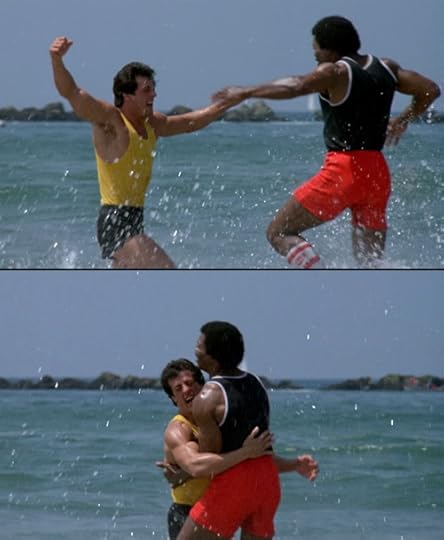
“Some feelings never die….”
—Dear God, the robot again. Now it’s scolding Paulie for his smoking, still in the sexy voice.
—The goodbye scene quotes Bill Conti music. Here’s a tip: don’t have your soundtrack composer quote better music than the stuff he’s been providing.
—ANOTHER MUSIC VIDEO MONTAGE. Full song again, and the lyrics describe exactly on the nose what the movie is about. The movie’s tagline could be, SUBTLETY IS THE FIRST CASUALTY.
—Okay, so Paulie grew up in Philly, and is freaked out by snow?
—Ooh, bad call. A training montage without “Gonna Fly Now?” Oh, and: ANOTHER MONTAGE.
—Rocky’s growing a beard while he trains in Siberia, which actually makes sense. But it’s a neatly-trimmed proto-metrosexual beard, which does not.
—Adrian: “I’m with you, no matter what.” Rocky: “No matter what?” Adrian: “No matter what.” DOUBLE SECRET FORESHADOWING, since this foreshadowing was foreshadowed by other foreshadowing.
—Bad call redux: another training montage that doesn’t have “Gonna Fly Now.” But the song does get credit for the line, “The cave that holds you captive has no doors.” Because if it did, that would make it a cellar, I guess. Oh, and: ANOTHER MONTAGE.
—I understand why Rocky’s sweating while he works out. But why is Duke the trainer sweating? And why is Paulie not?
—Paulie getting all teary before the fight and kissing Rocky on the cheek, all the while draped in an American flag? Weird. And overkill. That moment played much better in Rocky Balboa, without the flag.
—Dear God, the robot again. This time wearing a Santa beard, because it’s Christmas. And Rocky Jr. hanging out with other kids his age, written like movie kids as opposed to actual human children.
—Wait. Okay, so Rocky, Paulie, and Adrian are all in Russia. Did they leave the robot in charge of Rocky Jr.? And the robot let the kid invite friends over? The hell?
—Gorbachev! Well, Gorbachev-ish. Guess they couldn’t get the real deal like Faraway, So Close. (Will I ever think of him without recalling the scene from The Naked Gun when Leslie Niesen wipes off his birthmark? Probably not.)
—The first long shot that fully shows Rocky and Drago in the ring is the moment the movie loses all credibility. Before, against Apollo and Clubber Lang, Rocky might have been the underdog, but that was more a matter of skill and history; physically, they were pretty equal. But asking us to believe that 5’10” Stallone is an actual, physical threat to 6’5” Dolph Lundren is just too much. More than the sexy-talking robot, this puts us in the realm of science fiction.
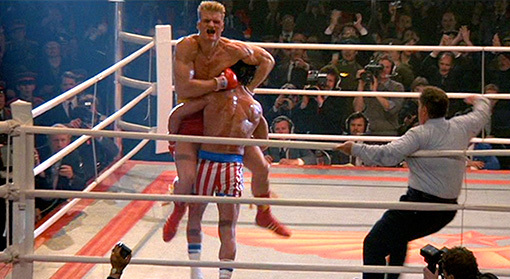
Glasnost! Okay, not really.
—Wow, this synth music during the fight sounds like a video game. Was there one? I’ll have to check… (Apparently not until 2002.)
—When Rocky punches Drago in slow motion, the sound effect is like a soaking-wet rag smacking the floor.
—Somehow Paulie rubbing Duke’s bald head for luck seems…un-PC.
—And now Rocky, draped in the American flag, makes a speech. I know Adrian is supposed to be overcome with emotion because of the fight, but Talia Shire looks like she’s totally embarrassed to be in this scene.
—Gorbachev leads the standing ovation. Because of course he would.
—And the final image, of course, is Rocky’s bloody face in front of an American flag. Because ‘Murica.
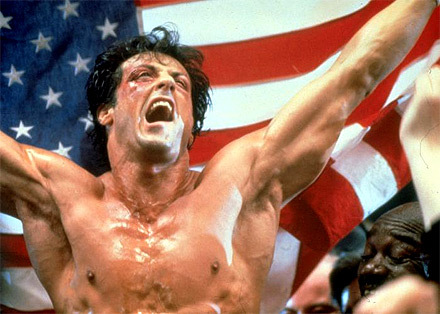
So, no: Rocky IV will not join my annual Thanksgiving Rocky-thon. I lived through it, and I can honestly say this movie is a distillation of everything that was wrong with the Eighties–knee-jerk patriotism (or just jerk patriotism), the Russians as vile automatons who lie and cheat without remorse (Apollo and Clubber Lang were villains, but they were honest in the ring; Drago is just a dick), black-and-white morality, and most importantly, not a single moment of honest, earned emotion. The Rocky films have always been full of mockable elements, but what made them forgivable was the emotion, that undeniable, original heart.
Rocky IV has no heart. Not even a burning one.
May 23, 2016
The Point of the End of the Tour
The End of the Tour is a film adapted from the memoir Although of Course You End Up Becoming Yourself: A Road Trip with David Foster Wallace, by David Lipsky. It begins with news of Wallace’s suicide* reaching Lipsky, who then digs out his audio tapes from the five days he spent with Wallace at the end of his author’s tour for Infinite Jest.
The movie does several things right. It definitely gets the feel of a book tour: the rental cars, hotel rooms and airports are impersonal, unfriendly and seem designed to suck all the enthusiasm from you. The hardworking book store personnel are glimpsed, as well as the contact person charged with getting Wallace on time to the bookstore, radio station and so forth. The three actual readings shown in the movie—one sparsely attended, the other two packed—both have the right atmosphere.

But that’s only window dressing on the central relationship, between Wallace (Jason Segel) and Lipsky (Jesse Eisenberg, looking like he’s never smoked before in his life), a Rolling Stone writer and unsuccessful novelist. Lipsky’s source book is literally a transcript of those tapes he accumulated, and the screenplay seems an accurate, if judiciously pruned, transcript of those transcripts.
The central problem is one that’s endemic to movies about writers: it’s pretty much impossible to show them doing the thing that makes them interesting. A movie about a musician can always show him or her performing; a biography of an actor can show the main character on stage or screen. But a writer? It’s impossible, as I wrote about two weeks ago.
The result is that Wallace comes across as a typically self-important “bro-lit” doufus. His responses to Lipsky’s questions aren’t those of a great intellect, but of a nervous guy suddenly caught in a spotlight he both courted and feared. Listening to him, the viewer can’t help but think, Why am I watching a movie about this guy?
But then you remember that the movie is about the patron saint of bro-lit.
In an article on The Cut last August, Molly Fischer observes:
“Make a passing reference to the ‘David Foster Wallace fanboy’ and you can assume the reader knows whom you’re talking about; he’s the type who’s pestered at least one woman to the point that she quit reading Infinite Jest in public. Infinite Jest — a novel that appears high on the list of ‘Books That Literally All White Men Own.’”
Well, I don’t. I’ve never read Infinite Jest. I’ve tried—just like I’ve tried The Fountainhead and Ulysses—numerous times, but I just can’t get past the dense, over 1,000-page, look-at-me pretentiousness of it all. As a writer, I typically try to stay out of the story’s way and tell it as simply and accessibly as possible; Wallace is the exact opposite of that, as was James Joyce, and possibly (though I can’t say for certain) for the same reason: big book equals big thoughts. And with lit-bros, that “big” standard also implies that something else is big (and I don’t mean hands).
I intended to try Infinite Jest again this spring, before I saw the movie, but every copy in our library system was checked out—apparently there’s an Infinite Summer reread in progress. It says something that you have to seek out peer pressure just to get through a book, but since I haven’t read it, I can’t say what. Perhaps it is the book the lit-bros claim it is. Perhaps it’s my pulp-sired, SF-reared white trash core that simply can’t comprehend its greatness.
Or maybe, to quote the patron saint himself (from page 36 of Lipsky’s book), it’s actually this:
“My tastes in reading lately have been way more realistic, because most experimental stuff is hellaciously unfun to read.”
As both a writer and a reader, I’d rather have fun.
*None of this is meant as any comment on Wallace’s subsequent death. I’ve been touched by suicide enough that I wouldn’t do that.



